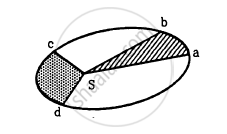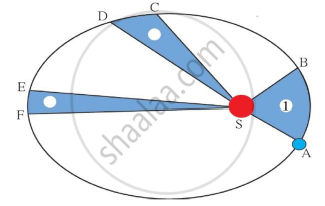Advertisements
Advertisements
प्रश्न
In the Following figure shows the elliptical path of a planet about the sun. The two shaded parts have equal area. If t1 and t2 be the time taken by the planet to go from a to b and from c to d respectively,

विकल्प
t1 < t2
t1 = t2
t1 > t2
insufficient information to deduce the relation between t1 and t2
उत्तर
t1 = t2
Kepler's second law states that the line joining a planet to the Sun sweeps out equal areas in equal intervals of time, i.e., areal velocity of a planet about the Sun is constant.
The given areas swept by the planet are equal, so t1 = t2
APPEARS IN
संबंधित प्रश्न
State Kepler's law of orbit and law of equal areas.
Let us assume that our galaxy consists of 2.5 × 1011 stars each of one solar mass. How long will a star at a distance of 50,000 ly from the galactic centre take to complete one revolution? Take the diameter of the Milky Way to be 105 ly
A comet orbits the Sun in a highly elliptical orbit. Does the comet have a constant (a) linear speed, (b) angular speed, (c) angular momentum, (d) kinetic energy, (e) potential energy, (f) total energy throughout its orbit? Neglect any mass loss of the comet when it comes very close to the Sun.
State Kepler's laws of planetary motion.
Identify the law shown in the figure and state three respective laws.

Answer the following question.
State Kepler’s law of the period.
Answer the following question in detail.
State Kepler’s three laws of planetary motion.
The orbit of a planet revolving around a star is _______.
The square of its period of revolution around the sun is directly proportional to the _______ of the mean distance of a planet from the sun.
Write the Kepler's laws.
State Kepler’s laws.
The mass and radius of earth is 'Me' and 'Re' respectively and that of moon is 'Mm' and 'Rm' respectively. The distance between the centre of the earth and that of moon is 'D'. The minimum speed required for a body (mass 'm') to project from a point midway between their centres to escape to infinity is ______.
The earth moves around the sun in an elliptical orbit as shown in the figure. The ratio, `"OA"/"OB"` = x. The ratio of the speed of the earth at Band at A is ______.

The centre of mass of an extended body on the surface of the earth and its centre of gravity ______.
- are always at the same point for any size of the body.
- are always at the same point only for spherical bodies.
- can never be at the same point.
- is close to each other for objects, say of sizes less than 100 m.
- both can change if the object is taken deep inside the earth.
Draw areal velocity versus time graph for mars.
What is the direction of areal velocity of the earth around the sun?
Earth’s orbit is an ellipse with eccentricity 0.0167. Thus, earth’s distance from the sun and speed as it moves around the sun varies from day to day. This means that the length of the solar day is not constant through the year. Assume that earth’s spin axis is normal to its orbital plane and find out the length of the shortest and the longest day. A day should be taken from noon to noon. Does this explain variation of length of the day during the year?
A planet revolving in an elliptical orbit has:
- a constant velocity of revolution.
- has the least velocity when it is nearest to the sun.
- its areal velocity is directly proportional to its velocity.
- areal velocity is inversely proportional to its velocity.
- to follow a trajectory such that the areal velocity is constant.
Choose the correct answer from the options given below:
